Shuttle SN27P2 SFF: AM2 gets the Tiny Treatment
by Jarred Walton on June 30, 2006 11:00 PM EST- Posted in
- Systems
Noise, Heat and Power
We mentioned already that the changes to our SFF test platform make it difficult to compare this new system with previous offerings. To provide something of an apples-to-apples comparison, we equipped an SN25P with an X2 4600+ (overclocked to 2.6 GHz to reach equivalent performance to the 5000+). Noise measurements were then taken at idle and at full load at a distance of 48", using both a 7900 GTX and an XFX 7600 GT XXX. Full load was achieved by running two instances of Folding@Home while looping 3DMark05. Idle measurements were taken with the system at the Windows desktop and no applications running. In order to measure CPU temperatures, we used the NVIDIA nTune 5.0 System Monitor; there may be differences between the motherboards and chipsets when reporting processor temperatures, but the important thing is that the systems run stable, and we can attest to the fact that none of the systems crashed during testing (except when we tried overclocking). Finally, system power draw was measured at the wall outlet using a Kill-A-Watt device.
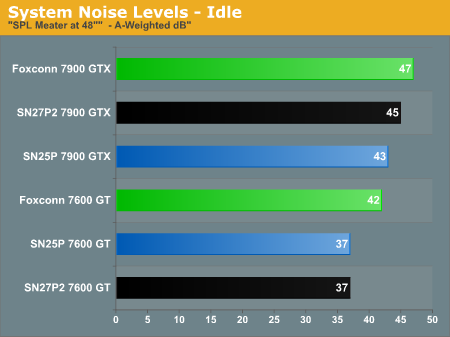
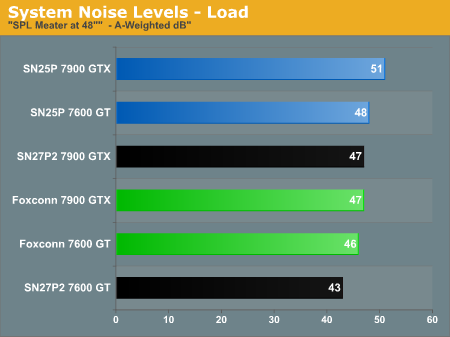
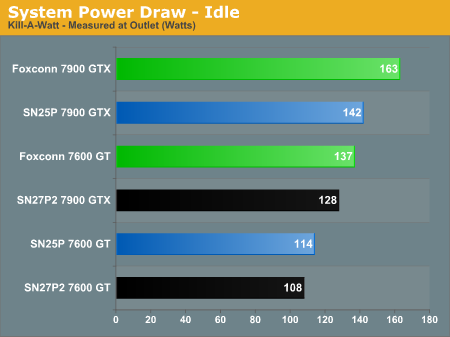
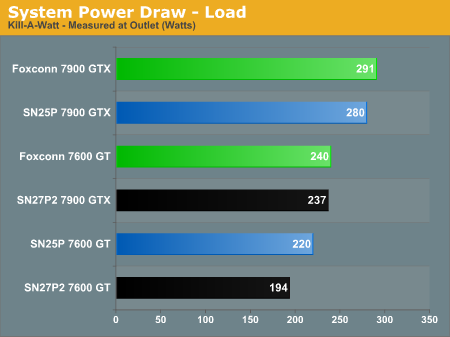
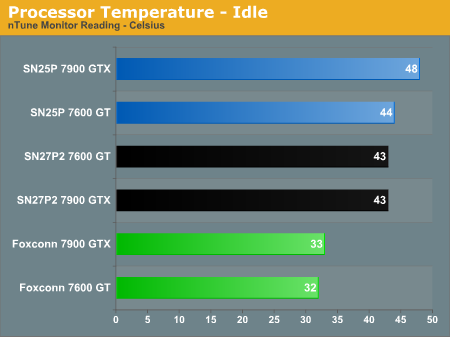
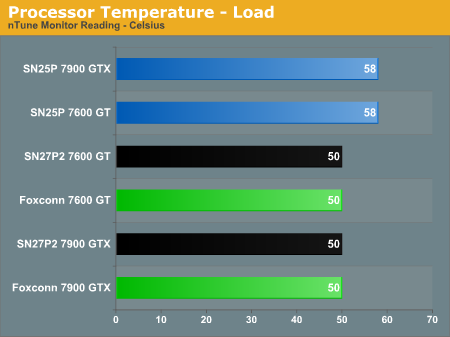
First, in terms of noise, the SN27P2 tends to run slightly quieter than the old SN25P. Looking at the power draw numbers, it also uses slightly less power, which probably accounts for the difference in noise levels that we're measuring. The difference in power draw is almost certainly caused by the switch from DDR to DDR2 memory -- 2.6V versus 2.0V in our test systems. Also note that the testing environment is slightly warmer than in previous SFF articles: 24°C versus 21°C. Testing during less hospitable times of day at room temperatures of 34°C did result in slightly higher noise levels at idle, but maximum noise level were generally consistent. The difference is that maximum noise levels were more easily achieved with a higher ambient temperature. It's definitely worth noting the relatively large difference in noise levels between the 7600 GT and 7900 GTX configurations. It doesn't matter as much in the ATX system, but in the SFF units the huge 7900 GTX card really adds a lot of noise at idle.
You can see that the noise and power testing hasn't changed radically from socket 939. When the system is idle, it is relatively quiet, and system power draw is within 15W. Once you place a full load on the processor -- especially if you put 100% load on both CPU cores -- the CPU fan speed and noise levels ramp up substantially, and the increased strain on the memory subsystem results in a 40W difference. Both SFF units still use less power than a full-size ATX motherboard, though likely that has as much to do with the 700 W OCZ power supply as it does with the motherboard size. In terms of CPU temperatures, it is important to note that both Shuttle systems are functioning with "smart" fan speed controls enabled, so the maximum CPU temperature is generally consistent while higher noise levels are generated under high CPU loads.
Provided you don't plan on running CPU intensive tasks 24/7, the typical noise levels are quieter than what most desktop systems provide. (Of course, you could also spend some effort to build a nearly-silent desktop PC if that's what you want.) If you pair the system up with a fanless GPU, it won't be silent, but it will also be far from annoyingly loud in most instances. Load up a game or perform some heavy video encoding -- or perhaps both at the same time -- and that assessment changes, of course.
We mentioned already that the changes to our SFF test platform make it difficult to compare this new system with previous offerings. To provide something of an apples-to-apples comparison, we equipped an SN25P with an X2 4600+ (overclocked to 2.6 GHz to reach equivalent performance to the 5000+). Noise measurements were then taken at idle and at full load at a distance of 48", using both a 7900 GTX and an XFX 7600 GT XXX. Full load was achieved by running two instances of Folding@Home while looping 3DMark05. Idle measurements were taken with the system at the Windows desktop and no applications running. In order to measure CPU temperatures, we used the NVIDIA nTune 5.0 System Monitor; there may be differences between the motherboards and chipsets when reporting processor temperatures, but the important thing is that the systems run stable, and we can attest to the fact that none of the systems crashed during testing (except when we tried overclocking). Finally, system power draw was measured at the wall outlet using a Kill-A-Watt device.






First, in terms of noise, the SN27P2 tends to run slightly quieter than the old SN25P. Looking at the power draw numbers, it also uses slightly less power, which probably accounts for the difference in noise levels that we're measuring. The difference in power draw is almost certainly caused by the switch from DDR to DDR2 memory -- 2.6V versus 2.0V in our test systems. Also note that the testing environment is slightly warmer than in previous SFF articles: 24°C versus 21°C. Testing during less hospitable times of day at room temperatures of 34°C did result in slightly higher noise levels at idle, but maximum noise level were generally consistent. The difference is that maximum noise levels were more easily achieved with a higher ambient temperature. It's definitely worth noting the relatively large difference in noise levels between the 7600 GT and 7900 GTX configurations. It doesn't matter as much in the ATX system, but in the SFF units the huge 7900 GTX card really adds a lot of noise at idle.
You can see that the noise and power testing hasn't changed radically from socket 939. When the system is idle, it is relatively quiet, and system power draw is within 15W. Once you place a full load on the processor -- especially if you put 100% load on both CPU cores -- the CPU fan speed and noise levels ramp up substantially, and the increased strain on the memory subsystem results in a 40W difference. Both SFF units still use less power than a full-size ATX motherboard, though likely that has as much to do with the 700 W OCZ power supply as it does with the motherboard size. In terms of CPU temperatures, it is important to note that both Shuttle systems are functioning with "smart" fan speed controls enabled, so the maximum CPU temperature is generally consistent while higher noise levels are generated under high CPU loads.
Provided you don't plan on running CPU intensive tasks 24/7, the typical noise levels are quieter than what most desktop systems provide. (Of course, you could also spend some effort to build a nearly-silent desktop PC if that's what you want.) If you pair the system up with a fanless GPU, it won't be silent, but it will also be far from annoyingly loud in most instances. Load up a game or perform some heavy video encoding -- or perhaps both at the same time -- and that assessment changes, of course.










17 Comments
View All Comments
Calin - Monday, July 3, 2006 - link
Most any ATX case will be quiter and possibly cooler inside than one of those SFF computers. However, they will be twice as big (or more). If that's ok with you, that's great - ATX all the way. If not, a laptop or a SFF certainly makes sense (even if the price is much better on the full ATX front).JarredWalton - Monday, July 3, 2006 - link
I don't know - it depends on the ATX case you're talking about and how many fans you want to install. If you install two or three case fans (or more) and they aren't temperature controlled, a lot of the less expensive ATX cases will be louder than many SFF cases. Lower quality power supplies will also make a lot of noise. If you don't want a big case, and you are interested in getting an extremely easy to set up bare-bones system, SFF computers are really very nice.I do wish prices were about $100 lower, however. $300 for a SFF I can justify; $400+ is a lot more difficult to stomach. For that much money, you can get a good power supply, motherboard, and pretty much any case that you want. I suppose part of it has to do with economies of scale; I don't know how many SFF cases Shuttle has sold, but I doubt they sell as many SFFs someone like ASUS would sell motherboards. That means all of their R&D costs that go into creating a smaller case have to be passed on as a larger percentage of the price.
JarredWalton - Saturday, July 1, 2006 - link
There was no opinion given on which CPU to choose, was there? I simply stated (and this is the expanded version) that even if you're going to buy AMD anyway and couldn't care less about Core 2 Duo, AMD has price cuts scheduled for July 24th so you can pick up an X2 CPU for a lot less than current prices. Here's my opinion:Core 2 Duo will be faster than anything AMD has to offer at least in the short term. AMD X2 will cost less at most (all?) price points, and in some cases (gaming), you're probably GPU limited either way since the current maximum for an SFF is going to be the 7950 GX2. I expect Shuttle will have the SD37P2 out some time after C2D launches, but since they're already 1 month behind the AM2 launch and you still can't purchase the SN27P2, that trend will likely continue and the SD37P2 won't be available until probably early September or so. (I could very well be wrong on that account, but I'm simply going by recent history.)
Which is the better choice? As you have so clearly demonstrated, that's a matter of personal taste. Some people are only going to buy AMD at present; others will only buy Intel. Most would like to buy whichever offers the best performance at a specific price point. I would guess that AMD will be competitive in the price/performance area even if C2D is faster overall, so in the end they get what they're happy with. I still wouldn't purchase an AM2 chip until those price cuts take affect.
VooDooAddict - Saturday, July 1, 2006 - link
Simply.
Will the 7950 Fit?
Does the BIOS support the card?
Can the powersupply keep it running with 2 gigs of RAM and a AMD 5000+?
As soon as I saw the 7950 anouncement all I could think about was building a new SFF system around it.
JarredWalton - Saturday, July 1, 2006 - link
I don't have one available, but my understanding is just about any motherboard with an X16 slot will work with the 7950 GX2. Since I managed to install a 7900 GTX in the SN37P2, I'm pretty sure the GX2 is actually a bit smaller overall, so it will certainly fit. Is it compatible? Well, the SN27P2 uses an NVIDIA chipset, so if it's *not* compatible, NVIDIA has a serious problem with support of GX2. In other words, I'm 99% certain that it will work.VooDooAddict - Monday, July 3, 2006 - link
I didn't think the issue was the chipset ... I thought it was the BIOS.JarredWalton - Monday, July 3, 2006 - link
Right, the BIOS needs to support non-graphics devices in the X16 slots. My point is that if a board using NVIDIA's chipset doesn't support NVIDIA's top GPU, what's the chance of getting everyone else to support it?